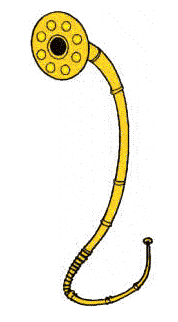| O.J.'s Trumpet Page | News, guide, forum |

More than 50 examples found in the nordic area
(North Germany, Denmark, Sweden and Norway)
Often found in pairs.
Mouthpiece very like a modern trombone mouthpiece.
The sound is closest to that of a tenor trombone.
Range: 8 - 10. partial, maybe up to 12. partial.
Length: 1,5 - 2,25 meter.
Conical
Caste in parts
"S"-form with a round decorative plate on the bell.
When in pairs they point in opposite direction (one look as seen in a
mirror)
No written sources but pictures of it can be seen on rock carvings
(e.g. Tanum in Baahuslen, Sweden).
2. The wooden Viking-lur
At Oseberg (close to where I live) they found a grave with a Viking
ship.
Excavated in 1904, the 21.5 metres long Oseberg
ship is the most magninficent
of the Viking ship finds.
The ship can be seen at the
Vikingskiphuset in Oslo.
In this grave find there was a lur, 1 meter long in 2 parts.
From literature one can guess that the lur has been used as a war
instrument.
The Oseberg instrument dates back to 850 A.C
It looks very much like the folk instrument used up to this century
among shepherds.
The main difference between the Oseberg lur and the shepherds lur is
that the last one is held together
with birch bark. The viking lur parts were held together with willow
rings.
3. The lur used today
The lur is stilled used.
A great player is Odd Lund. He performed on the opening of the
1994 Olympic Game in Lillehammer, and on the Nordic Ski World
Championship, 1997 in Trondheim. He has made a CD where he plays both the lur and
other natural instruments like the Rams Horn.
I play a lur (Bb tuning), made by the craftsman Magnar Storbækken, Tollgjelen, 2540 Tolga, NORWAY.
